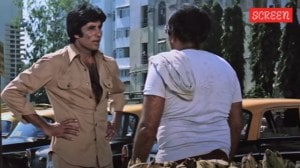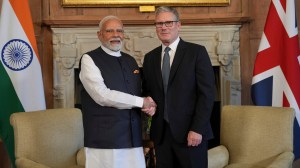Click here to join Express Pune WhatsApp channel and get a curated list of our stories
Sassoon Hospital, a Jewish merchant’s enduring gift to Pune which he didn’t live to see
Through Sassoon Hospital, David Sassoon wished “to relieve the wants of the poor of Poona” and contributed more than half of the money used to build it.
 “I feel the least hesitation in expressing my belief that one of the most cherished schemes of my life will be fully realised,” said Sassoon during the foundation stone laying ceremony.
“I feel the least hesitation in expressing my belief that one of the most cherished schemes of my life will be fully realised,” said Sassoon during the foundation stone laying ceremony.
On October 8, 1863, the then Bombay Governor Henry Bartle Frere laid the foundation stone of Sassoon General Hospital in Pune in the presence of Baghdadi Jewish baron David Sassoon.
In his speech, Frere liberally praised then-71-year-old Sassoon’s philanthropy, who had donated Rs 1.88 lakh for the establishment of the public institution, and hoped that “providence should permit him to see the building suitably completed”.
“I feel the least hesitation in expressing my belief that one of the most cherished schemes of my life will be fully realised,” said Sassoon during the foundation stone laying ceremony. However, his wish did not come true during his life time.
Sassoon, the then Bombay-based owner of David Sassoon, Sons & Company, who had a summer residence in Pune, called Garden Reach, died in the city in November 1864 before the hospital became operational.
“The venerable David Sassoon, head of the Jewish community of Western India, and a merchant-prince of worldwide reputation, died in the city of Poona on the 5th instant after a day’s illness…Bombay has lost one of its most energetic, wealthy, public-spirited and benevolent citizens,” read an obituary in an English newspaper.
From Baghdad to Bombay
Born in 1793 in a family of official treasurers of the ruler of Baghdad, David ben Sassoon left the city with his family in the 1830s because of the mal-treatment of Jews under the reign of Daoud Pasha and reached Basra. In 1832, he visited Bombay for the first time, and, beguiled by the “beauty and promise” of the city, shifted his family to the city for good. Once here, since surnames were customary, he became David Sassoon.
When Sassoon made Bombay his home, it was a gateway to India from Europe and many traders from the West and Middle East made their way to the city to have a share in the trade pie and hoped to build a fortune. It was also a time when the British government had weakened the trading monopoly of the East India Company.
Sassoon started small in the Indo-Persian trade of English textiles and Oriental weaves. He deployed his knowledge and connections in Persia and Baghdad to expand the trade and soon became a big player in the market.
“It was a turning point in the history of his business, for it was this that gave him the clue of the boundless potentialities of his new place of residence. England knew it as the gateway that gave access to India, (Sassoon) realized that Bombay was not only the Gateway to India but a gateway to China. That was David Sassoon’s great discovery which was rewarded by a shower of gold,” Cecil Roth wrote in his history of the family, The Sassoon Dynasty, published in 1941.
Sassoon started trading with China and the Far East by dealing in yarn, gold, and, most importantly, opium which later played a large role in his immense financial success. “It was the China trade that raised the house to the very first rank in British India. By 1854, David Sassoon was considered a millionaire; he was far more than this by the time of his death,” according to Roth’s book.
His firm developed a practical monopoly in the trade of opium, fabrics, and cotton yarn with branches in Calcutta, Shanghai, Canton, Hong Kong, Yokohama, and Nagasaki. Considering the political support required for such large operations, including the contentious ones such as the opium trade in China, Sassoon aligned closely with the British government.
Most cherished scheme
Sassoon is known to have donated large sums of money towards building several institutions in Bombay, including the Sassoon Library and Reading Room, the Industrial and Reformatory Institution, the Clock Tower, and the Magen David Synagogue.
In Pune, he donated Rs 50,000 to build the Poona Infirm Asylum, now known as Niwara, and the Ohel David Synagogue, which is locally known as Laal Deval.
But his most significant, and also the most impactful, contribution came when he decided to spearhead the establishment of a public hospital in Pune in 1863 — the Sassoon General Hospital — which continues to be the largest public hospital in the region. Before the Sasson General’s establishment, the only hospital in Pune was the Civil Hospital with a capacity to accommodate only 50 patients.
The hospital was a special project for him. As per a report in The Illustrated London News in late 1862, Sassoon “wishing to relieve the wants of the poor of Poona” laid before the government an offer to contribute towards building a hospital.
The total cost of the construction was pegged at Rs 3,10,060, with Sassoon contributing Rs 1,88,000.
When it was opened in 1867, the hospital designed by Lieutenant Colonel Wilkins could accommodate 144 patients, each with 75 square feet of surface area and 1,400 cubic feet of space. In times of emergency, the verandas could house an additional 60 individuals.
“The building in the English Gothic style, has a very imposing appearance, with its massive clock tower. It consists of two floors, which have lofty roofs, perfect ventilation, and as an internal arrangement simple but admirable,” said The Illustrated London News about the hospital.
A polymath who didn’t know English
During the ceremony to lay the foundation stone of Sassoon Hospital, Governor Frere was full of praise for the Jewish patriarch, his philanthropy, and his decision to send some of his sons to Europe for higher education. Sassoon’s brief statement would have been hardly comprehensible to the governor as he delivered it in his native tongue: Arabic.
Historians of the Jewish diaspora say Sassoon received only religious education as a child and was fluent in Hebrew, Persian, and Turkish apart from his native language Arabic. After migrating to India, he had learnt to communicate in Hindustani to the extent that it helped him do his business communications. “But this multi-millionaire who rose to fame and fortune under the British flag never mastered English,” according to Roth’s book.
As a religious man, he devoted his time to the study of scriptures and the offices of his firm remained shut on Sabbath (Saturday) in addition to Sunday as per local custom. “Every Saturday, the heads of the Bombay Jewish community assembled in David Sassoon’s house, accompanied by such native and foreign scholars as were available. The afternoon would be occupied with study of the Zohar and Talmud,” says Roth’s book.
One of his contemporaries described Sassoon as having a particularly impressive appearance: He was extremely tall, standing head and shoulders above the average inhabitants of Bombay, wearing Oriental garments and head-dress that added to his dignity and his apparent height – he never abandoned the Baghdadi costume of his youth.
When he died in November 1864, he left a large family behind including six sons, four daughters, and his larger family – the Baghdadi Jewish community of Bombay. He was buried in the courtyard of Ohel David Synagogue in Pune which he had established in the city where he breathed his last.
‘2,000 patients reporting daily’
Sassoon’s grandson Jacob, from his younger son Elias David, donated Rs 2 lakh in 1906 for the expansion of the hospital by establishing a new wing exclusively meant for European patients and those from the Jewish community. The foundation stone of the building was laid by the then-Bombay Governor Lord Lamington.
In November 1878, a medical school was started on the campus which would later grow into the B J Medical College.
The hospital provided medical services to the people of Pune, especially during the plague pandemic that started in 1897. It was also the hospital where Mahatma Gandhi was repeatedly admitted during his imprisonment in the city’s Yerwada Prison and underwent surgery to remove an inflamed appendix in January 1924.
“Presently, at least 2,000 patients are reporting daily at the Out Patient Department apart from another 200-220 admissions,” says Dr Sanjiv Thakur, Dean, Sassoon General Hospital and B J Medical College. “It’s a tertiary care centre for Western Maharashtra where poor and needy patients get gold-standard treatment so that they are not deprived of better care,” adds Dr Thakur.
Financially weak and meritorious students come here for graduate and postgraduate studies.
Presently, both the heritage buildings – the David Sassoon and Jacob Sassoon buildings – are undergoing restoration. The work began in November 2022 and Rs 14.7 crore will be spent on the restoration work of the David Sassoon Hospital building and Rs 9 crore on the Jacob Sassoon building.
Archana Deshmukh Kulkarni, a conservation architect at Nasadeeya Architecture and Conservation appointed by the Public Works Department, Government of Maharashtra, for the restoration project, said that 50 per cent of the work has been completed.
“David Sassoon built a typical early English Gothic style with high walls and sloping roof, while the Jacob Sassoon building is more of the later Victorian Gothic style with elaborately panelled front doors, pointed arches and towers.”
“We are keen to bring these buildings back to their original glory,” says Kulkarni.
Click here to join Express Pune WhatsApp channel and get a curated list of our stories











